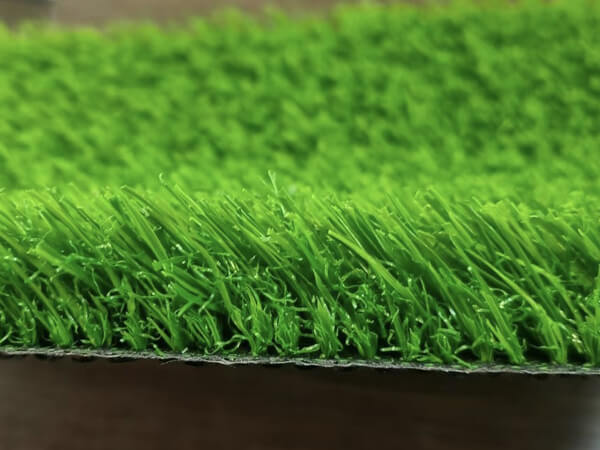
Drainage and Backing Specifications: Artificial Grass for Sports vs. Landscape Applications
Core Differences Summary
Feature | Sport Turf Grass | Landscape Artificial Turf |
Primary Need | Excellent Drainage, Extreme Stability, Player Safety | Basic Drainage, Environmental Safety, Cost Control, Aesthetics |
Drainage Hole Requirements | High Density, Large Aperture, Scientific Layout | Basic Density, Moderate Aperture or Not Required |
Backing Coating Requirements | High-Strength SBR Latex, Full Coating, High Weight | SBR Latex or Eco-Friendly Coating (e.g., PU), Dot or Full Coating, Moderate Weight |
I. Requirements for Sport Turf Grass
Sport turf grass faces extreme conditions such as high-intensity trampling, rapid running, and sharp cleat impacts. Therefore, its requirements for stability and drainage are of the highest level.
I-1. Sport Turf Grass Drainage Hole Requirements for Optimal Performance
- High Density & Large Aperture: The drainage holes on the backing of sport turf grass
grass are more numerous (high density) and have a larger diameter. This ensures rapid drainage during heavy rain or irrigation, preventing water accumulation and allowing immediate reuse. FIFA-certified fields require a drainage rate of 60 mm/hour, directly dependent on excellent drainage hole design.
- Scientific Layout: The arrangement of drainage holes is not random but designed based on fluid dynamics to ensure uniform and efficient water passage through the base layer into the underlying stone subbase and drainage network.
- Purpose:
- Ensure uninterrupted games and training.
- Prevent water accumulation leading to player slips and injuries.
- Protect grass fibers and infill from water immersion, extending lifespan.
I-2. Sport Turf Grass Backing Coating Requirements for Durability and Safety
- Material: Must use high-strength SBR Latex. This coating offers exceptional grip, anti-aging properties, and elasticity, withstands long-term mechanical stress.
- Process: Must be full coating. The backing coating fully and uniformly encapsulates the grass tufts and the entire primary backing. This ensures:
- High Tuft Bind: Grass fibers are firmly secured, preventing detachment or pull-out during high-speed friction and cleat hooking.
- Excellent Stability: The full coating binds grass fibers, primary backing, and infill (sand and rubber granules) into a solid whole, preventing base layer displacement, wrinkling, or deformation, providing a consistent and safe playing surface.
- Weight: The coating weight (grams per square meter) is higher to ensure strength and durability.
![Sport Turf Grass Display]()
Landscape artificial turf is primarily used for decoration, greening, walkways, etc. Its core needs are aesthetics, environmental friendliness, durability, and cost-effectiveness. Requirements for drainage and extreme physical stability are relatively lower.
II-1. Landscape Artificial Turf Drainage Hole Requirements for Proper Water Flow
- Basic Drainage Sufficiency: Landscape artificial turf also requires drainage holes to prevent water pooling, but the requirements are far lower than for sports turf grass. It only needs to handle natural rainfall, not instant large-volume drainage.
- Moderate Density and Aperture: Typically, standard density and aperture designs are used, sufficient for daily drainage needs. Some very low-end landscape artificial turf may even lack pre-punched drainage holes, relying on installation seams or natural permeability (not recommended).
- Purpose:
- Prevent rainwater accumulation, keeping the surface dry and clean.
- Avoid mold formation at the base due to prolonged immersion.
II-2. Landscape Artificial Turf Backing Coating Requirements for Strength and Longevity
- Diverse Materials:
- SBR Latex: Used in mid-to-high-end landscape artificial turf , offering good durability and fiber fixation.
- PU Backing: An eco-friendlier option, odor-free, heavy-metal-free, with low VOCs emissions. Commonly used in kindergartens, home gardens, and other environmentally sensitive areas. Its anti-aging and grip properties are continually improving.
- Other Composite Backings: Such as PP backing, with lower costs.
- Process:
- Dot Coating or Semi-Coating: Many landscape artificial turfs use dot coating, where adhesive is applied in dots on the backing. This secures the grass fibers while saving material, reducing costs and product weight for easier transportation and installation.
- Full Coating: High-end landscape grass or products for higher-traffic public areas (e.g., terraces, hotels) may use full coating to enhance durability and UV resistance.
- Weight: Generally lower than sports grass to control costs.
![Landscaping Artificial Turf Display]()
Summary and Selection Guide
Application Scenario | Recommended Drainage Holes | Recommended Backing Type | Reason |
Professional Soccer Fields, Rugby Fields | High density, large aperture | Full-coating high-strength SBR latex | Meets international standards, ensures safety, performance, and extreme durability |
Community Sports Fields, School Playgrounds | Medium to high density | Full-coating SBR latex | Balances performance, safety, and cost, withstands high usage intensity |
Home Lawns, Balconies | Basic drainage holes | Dot/full-coating SBR or eco-friendly PU backing | Focus on environmental safety, odor-free, meets daily drainage and walking needs |
Municipal Greening, Public Landscaping | Basic drainage holes | Dot-coating SBR backing | Controls costs for large-scale installation, meets basic functional needs |
Kindergartens, Pet Areas | Basic drainage holes | Eco-friendly PU backing | Prioritizes environmental and health safety, prevents harmful substance release |
When selecting artificial turf, it is essential to determine whether its backing and drainage holes are suitable based on the intended use. Using landscape artificial turf on sports fields poses significant safety risks and functional issues, while using expensive sports turf grass for general landscaping is an unnecessary waste of resources. When purchasing, request samples to visually compare backing processes, coating weight, and drainage hole design.




















